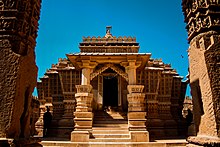
A torana is a free-standing ornamental or arched gateway for ceremonial purposes in Hindu, Buddhist and Jain architecture of the Indian subcontinent. Toranas can also be widely seen in Southeast Asia and parts of East Asia. Chinese Shanmen gateways, Japanese torii gateways, Korean Iljumun and Hongsalmun gateways, Vietnamese Tam quan gateways, and Thai Sao Ching Cha were derived from the Indian torana. They are also referred to as vandanamalikas.

The Dilwara Temples or Delvada Temples are a group of Śvētāmbara Jain temples located about 2+1⁄2 kilometres from the Mount Abu settlement in Sirohi District, Rajasthan's only hill station. The earliest were built by Bhima I and supposedly designed or at least financed by Vastupala, Jain minister of Dholka. They date between the 11th and 16th centuries, forming some of the most famous monuments in the style of Māru-Gurjara architecture, famous for their use of a very pure white marble and intricate marble carvings. They are managed by Seth Shri Kalyanji Anandji Pedhi, Sirohi and are a pilgrimage place for Jains, and a significant general tourist attraction. The Dilwara temples are regarded as the most impressive among Jain temples in Rajasthan.

Jaisalmer, nicknamed "The Golden city", is a city in the Indian state of Rajasthan, located 575 kilometres (357 mi) west of the state capital Jaipur. It is the administrative headquarters of Jaisalmer District. Before Indian independence, the town served as the capital of the Jaisalmer State, ruled by the Bhati Rajputs. Jaisalmer stands on a ridge of yellowish sandstone and is crowned by the ancient Jaisalmer Fort. This fort contains a royal palace and several ornate Jain temples. Many of the houses and temples of both the fort and of the town below are built of finely sculptured sandstone. The town lies in the heart of the Thar Desert and has a population, including the residents of the fort, of about 78,000.
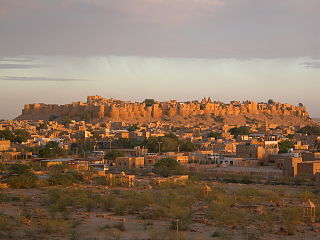
Jaisalmer Fort is situated in the city of Jaisalmer, in the Indian state of Rajasthan. It is one of the very few "living forts" in the world, as nearly one fourth of the old city's population still resides within the fort. For the better part of its 860-year history, the fort was the city of Jaisalmer. The first settlements outside the fort walls, to accommodate the growing population of Jaisalmer, are said to have come up in the 17th century.
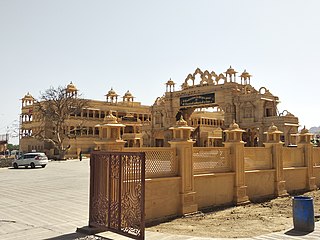
Jirawala Tirth is a Jain temple in Jirawala village of Sirohi District in Rajasthan, India. It lies 58 km from Abu Road. The temple is considered an important Jain pilgrimage center.

Rajasthan is one of the most popular tourist destinations in India, for both domestic and international tourists. Rajasthan attracts tourists for its historical forts, palaces, art and culture with its slogan "Padharo Mhare Desh " The capital city, Jaipur, also known as Pink City, is a very popular tourist destination and is a part of the Golden Triangle. The Walled City of Jaipur is only the second Indian city to be recognized as a UNESCO World Heritage Site, after Ahmedabad.
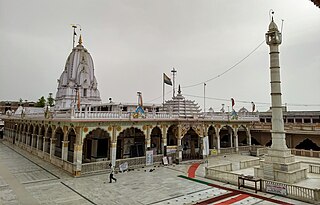
Tijara Jain Temple is a digambar Jain temple dedicated to Chandraprabhu. The temple is located in the hill town Tijara, in the Alwar district of Rajasthan, India. It is an Atishaya Kshetra. It is 55 kilometres (34 mi) from Alwar and 110 kilometres (68 mi) from Delhi. The location is a tirtha for the Jains and a tourist attraction.

Jaisalmer State was a Bhati Rajput kingdom in the far-western part of present-day Rajasthan, India, from the mid-12th century CE until 1947. In 1156 CE, Rawal Jaisal moved his capital from Ludarva to Jaisalmer because the former was vulnerable to attacks from Turko-Afghan and Baloch tribes. The descendants of Jaisal continued to exercise absolute control over Jaisalmer until 1818 CE, when a treaty of subsidiary alliance with the British Empire made it a princely state, a British Protectorate still running its own internal affairs. Known as the Maharawal, the native ruler of the princely state was entitled to a 15-gun salute.

Lodrawa is a village in Jaisalmer district, Rajasthan, India. It is located 15 kilometers to the north-west of Jaisalmer. Lodrawa was the ancient capital of the Bhati Rajputs until Rawal Jaisal founded the Jaisalmer state and moved the capital to Jaisalmer in 1156 CE.

Ranakpur Jain temple or Chaturmukha Dharana Vihara is a Śvētāmbara Jain temple at Ranakpur dedicated to Tirthankara Rishabhanatha. The temple is located in a village of Ranakpur near Sadri town in the Pali district of Rajasthan.

Hill Forts of Rajasthan are six forts, spread across Rajasthan state in northern India. They have been clustered as a series and designated as a UNESCO World Heritage Site in 2013. The hill forts series include - Chittor Fort at Chittorgarh, Kumbhalgarh Fort at Rajsamand, Ranthambore Fort at Sawai Madhopur, Gagron Fort at Jhalawar, Amer Fort at Jaipur and Jaisalmer Fort at Jaisalmer.
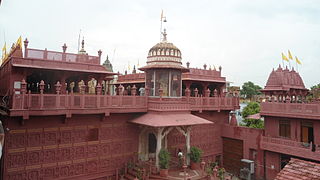
Shri Digamber Jain Atishya Kshetra Mandir, Sanghiji is an ancient Jain Temple in Sanganer, Rajasthan made of red stone. The ancient Shri Digamber Jain temple of Sanganer is 16 km from Jaipur.
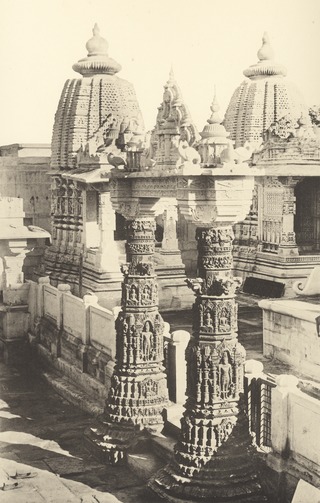
The Mahavira Jain temple is built in Osian of Jodhpur District, Rajasthan. The temple is an important pilgrimage of the Oswal Jain community. This temple is the oldest surviving Jain temple in Western India and was built during the reign of Mahārāja Śrī Vatsarāja of Imperial Pratihāras. The temple is visited by both Jain and Hindu.
Panchasara Parshwanath temple is a Jain temple located in Patan, Gujarat. The temple was constructed in 8th century during the reign of Vanaraja Chavda of Chavda dynasty.

The Kumbharia Jain temples is a group of five Jain temples in the Kumbhariya, Banaskantha district in Gujarat, India. Constructed from 1062 to 1231 CE during the reign of the Chaulukya dynasty, they are noted for their elaborate architecture.

Jaisalmer Fort Jain temples is a group of seven Jain temples inside Jaisalmer Fort in state of Rajasthan. The Jaisalmer Fort is UNESCO World Heritage Site as part of Hill Forts of Rajasthan and is famous for its ancient Jain temples. The temples are well known for their intricate carvings and attract many tourists and religious devotees.

The Ahichchhatra Jain temples is a group of Jain temples in Ahichchhatra village in Aonla tehsil of Bareilly district in Uttar Pradesh, North India. Ahichchhatra is believed to be the place where Parshvanatha, the 23rd Tirthankar of Jainism, attained Kevala Jnana.
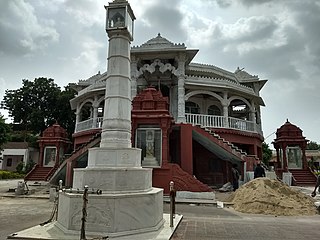
Bijolia Parshvanath Temple or Tapodaya Teerth Kshetra is a Jain pilgrimage center located in Bijolia town in Bhilwara district of Rajasthan.
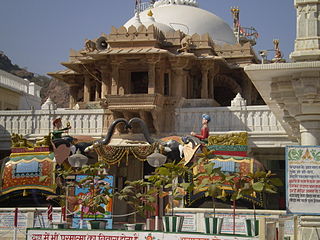
Nakodaji Tirth is a major Jain tirth in the Indian state of Rajasthan, located between the villages of Vikrampura and Nakoda in Barmer District. The temple houses the icon of Nakoda Bhairava, a popular Shvetambara guardian deity.

Kesariyaji Tirth or Rishabhdeo Jain temple is a Jain temple located in Rishabhdeo town of Udaipur District of Indian state of Rajasthan. The temple is considered an important pilgrimage center by both Digambara and Śvētāmbara sect of Jainism.
